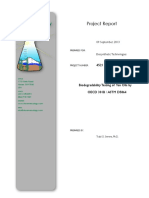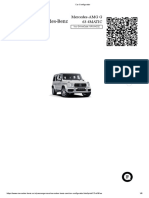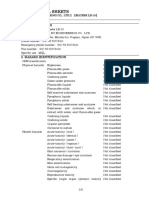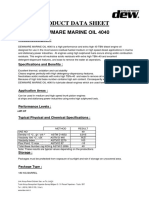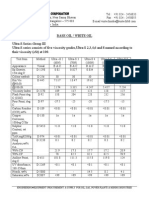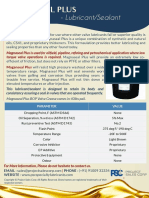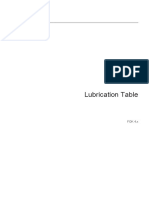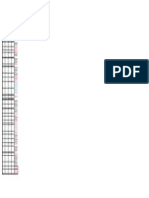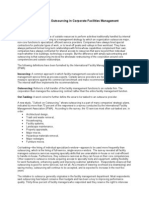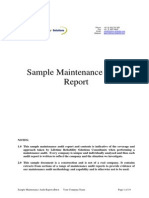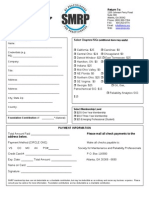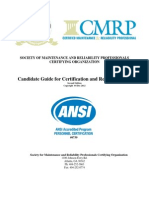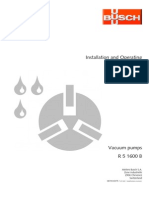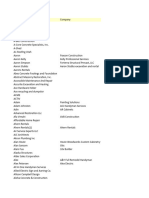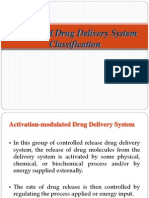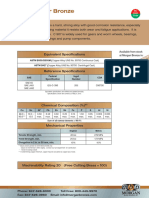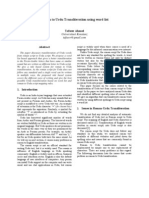Engen Transformer Oil PDF
Engen Transformer Oil PDF
Uploaded by
Ursula JohnsonCopyright:
Available Formats
Engen Transformer Oil PDF
Engen Transformer Oil PDF
Uploaded by
Ursula JohnsonOriginal Description:
Original Title
Copyright
Available Formats
Share this document
Did you find this document useful?
Is this content inappropriate?
Copyright:
Available Formats
Engen Transformer Oil PDF
Engen Transformer Oil PDF
Uploaded by
Ursula JohnsonCopyright:
Available Formats
ENGEN TRANSFORMER OIL
MATERIAL SAFETY DATA SHEET
1. PRODUCT AND COMPANY IDENTIFICATION Product name Product use Supplier Health Emergency Telephone Transport Emergency Telephone Customer Service Center MSDS Internet website : : : : : : : ENGEN TRANSFORMER OIL Transformer oil
Revision Date
: 23.06.2006
Engen Petroleum Limited (Tel: 021-403 4911, a/h: 021-403 4099) 021-658 5111 (Red Cross Poison Service) 011-975 1278/83 (Hazchemwise) 0860 036 436 (Sales and Technical Information) www.engen.co.za/content/products/default2.htm
2. COMPOSITION/INFORMATION ON INGREDIENTS Chemical name Solvent-refined light naphthenic distillate Additives CAS-No. 64741-97-5 Weight% > 95.00 < 5.00 Symbol Codes None None R-Phrase Numbers Not Applicable Not Applicable
See Section 15 for European Label Information. See Section 8 for Exposure Limits (if applicable).
3. HAZARDS IDENTIFICATION Emergency response data Potential health effects Note : No significant effects expected. : Light Amber Liquid. DOT ERG No. - Not applicable.
See Section 11 for further health effects/toxicological data. 4. FIRST AID MEASURES Inhalation : Not expected to be a problem. However, if respiratory irritation occurs due to excessive vapour or mist exposure, seek immediate medical assistance. Remove contaminated clothing. Dry wipe exposed skin and cleanse with hand cleaner, soap and water. Launder contaminated clothing before reuse. (See Section 16 - Injection Injury) Flush thoroughly with water. If irritation occurs call a doctor. Not expected to be a problem. However, if discomfort occurs seek medical attention. Do not induce vomiting.
Skin contact
Eye contact Ingestion
: :
5. FIRE-FIGHTING MEASURES Extinguishing media Special fire fighting procedure : : Carbon dioxide, foam, dry chemical and water fog. Water or foam may cause frothing. Use water to keep fire exposed containers cool. Water spray may be used to flush spills away from exposure. Prevent runoff from fire control or dilution from entering streams, municipal sewers, or drinking water supply. For fires in enclosed areas, fire fighters must use Self-Contained
Special protective
ENGEN TRANSFORMER OIL
equipment for firefighters Unusual fire and explosive hazards Products of decomposition Flash Point Upper Explosion Limit Lower Eplosion Limit NFPA Hazard Id : : : : : : Breathing Apparatus. None. Fumes, smoke, carbon monoxide, sulphur oxides, aldehydes and other decomposition products, in the case of incomplete combustion. > 140 C (ASTM D-93) 7 %(V) 0.9 %(V) Health: 0; Flammability: 1; Reactivity: 0
6. ACCIDENTAL RELEASE MEASURES Procedure if material is released or spilled Methods for cleaning up : : Report spills/releases as required to appropriate authorities. LAND SPILL: Shut off source taking normal safety precautions. Take measures to minimize the effects on ground water. Recover by pumping using explosion-proof equipment or contain spilled liquid with sand or other suitable absorbent and remove mechanically into containers. If necessary, dispose of absorbed residues as directed in Section 13. WATER SPILL: Notify port and relevant authorities. Confine with booms if skimming equipment is available to recover the spill for later recycling or disposal. Prevent spill from entering municipal sewers, water sources or low lying areas. Advise the relevant authorities if contaminations have occurred.
Environmental precautions
7. HANDLING AND STORAGE Safe handling advice : No special precautions are necessary beyond normal good hygiene practices. See Section 8 for additional personal protection advice when handling this product. Keep containers closed when not in use. Do not store in open or unlabelled containers. Do not store near heat sources, sparks, flames, strong oxidizing agents and combustible materials. Prevent small spills and leakages to avoid slip hazard.
Storage information
Storage and handling procedures
8. EXPOSURE CONTROLS / PERSONAL PROTECTION Occupational Exposure Limits (OELs) Components Solvent-refined light naphthenic distillate CAS-No. 64741-97-5 Source ACGIH TLV TWA LTEL STEL 5 mg/m3 10 mg/m3 Value Notations Oil mists
LTEL: Long Term Exposure Limits - Time Weight Average (TWA) over 8 hours. STEL: Short Term Exposure Limits - Time Weight Average (TWA) over 15 Minutes Note: Limits Shown for guidance only. Follow applicable regulations. Personal Protection Equipment (PPE) Engineering controls Respiratory protection Eye protection Skin and body protection : : : : If mists are generated, use ventilation, local exhaust or enclosures to control below exposure limits. Approved respiratory equipment must be used when mist concentrations exceed the recommended exposure limits. If splash with liquid is possible, chemical type goggles should be worn. No special equipment required. However, if frequent splashing or liquid
ENGEN TRANSFORMER OIL
contact is likely to occur, wear oil impervious gloves and clothing. Good personal hygiene practices should always be followed. 9. PHYSICAL AND CHEMICAL PROPERTIES Appearance Colour Odour Solubility Boiling point/range Flash Point Vapour pressure Density Pour point Viscosity, kinematic : : : : : : : : : : Liquid. Light Amber Mild Negligible > 260 C > 140 C (ASTM D-93) < 0.1 hPa 0.8880 g/cm3 @ 20 C (ASTM D-4052) -45 C 7.6 mm2/s @ 40 C (ASTM D-445)
10. STABILITY AND REACTIVITY Stability Conditions to avoid Materials to avoid Hazardous decomposition products : : : : Stable. Extreme Heat. Strong oxidizers. Fumes, smoke, carbon monoxide, sulphur oxides, aldehydes and other decomposition products, in the case of incomplete combustion.
11. TOXICOLOGICAL INFORMATION Acute oral toxicity Acute inhalation toxicity : : (Rats): Practically non-toxic (LD50: Greater than 2000 mg/kg). Based on testing of similar products and/or components. Not applicable. Harmful concentrations of mists and/ or vapours are unlikely to be encountered through any customary or reasonably foreseeable handling, use, or misuse of this product. (Rabbits): Practically non-toxic (LD50: greater than 2000 mg/kg). Based on testing of similar products and/or the components. (Rabbits): Practically non-irritating. (Primary Irritation Index: 0.5 or less). Based on testing of similar products and/or the components. (Rabbits): Practically non-irritating. (Draize score: greater than 0 but 6 or less). Based on testing of similar products and/or the components. Severely solvent refined and severely hydrotreated mineral base oils have been tested at an Environmental and Health Sciences Laboratory by dermal application to rats 5 days/week for 90 days at doses significantly higher than those expected during normal industrial exposure. Extensive evaluations including microscopic examination of internal organs and clinical chemistry of body fluids, showed no adverse effects. Chronic mouse skin painting studies of severely solvent refined mineral base oils showed no evidence of carcinogenic effects. Overexposure to oil mist may result in oil droplet deposition and/or granuloma formation.
Acute dermal toxicity Skin irritation Eye irritation Repeated dose toxicity
: : : :
Carcinogenicity
Other toxicological information
12. ECOLOGICAL INFORMATION Elimination information (persistence and degradability) Biodegradability Physico-chemical : : This product is expected to be inherently biodegradable at a slow to moderate rate. Adsorption to sediment and soil will be the predominant behaviour.
ENGEN TRANSFORMER OIL
removability Bioaccumulation Ecotoxicity effects Toxicity to aquatic organisms : This substance is practically non-toxic to aquatic organisms (LL50: >1000 mg/l). : Minimal owing to low water solubility.
Further information on ecology Remarks : In the absence of specific environmental data for this product, this assessment is based on information for representative substances.
13. DISPOSAL CONSIDERATIONS Waste disposal : Product is suitable for burning in an enclosed, controlled burner for fuel value or disposal by supervised incineration. Such burning may be limited pursuant to the Resource Conservation and Recovery Act. In addition, the product is suitable for processing by an approved recycling facility or can be disposed of at any government approved waste disposal facility. Use of these methods is subject to user compliance with applicable laws and regulations and considerations of product characteristics at time of disposal. The unused product, in our opinion, is not specifically listed by the EPA as a hazardous waste (40 CFR, Part 261D), nor is it formulated to contain materials which are listed hazardous wastes. It does not exhibit the hazardous characteristics of ignitability, corrosivity, or reactivity and is not formulated with contaminants as determined by the Toxicity Characteristic Leaching Procedure (TCLP). However, used product may be regulated. > 140 C (ASTM D-93)
Other regulations
Flash Point
14. TRANSPORT INFORMATION Note Static Accumulator (50 picosiemens or less) : : This product is not regulated by the following: U.S. DOT (CFR), ADR, IATA and IMDG. Yes
15. REGULATORY INFORMATION US OSHA Hazard Communication Standard Governmental Inventory Status EU Labelling SARA U.S. Superfund Amendments and Reauthorization Act SARA Title III SARA (311/312) Reportable Hazard Categories : This product contains no "EXTREMELY HAZARDOUS SUBSTANCES". : : : When used for its intended purposes, this product is not classified as hazardous in accordance with OSHA 29 CFR 1910.1200. All components comply with TSCA, EINECS/ELINCS, AICS, METI, DSL, KECI, ENCS, PICCS and IECSC. Product is not dangerous as defined by the European Union Dangerous Substances/Preparations Directives. EU labelling not required.
None
The following product ingredients are cited on the lists below Chemical name Solvent-refined light naphthenic distillate Additives CAS-No. 64741-97-5 Concentration [%] > 95.00 < 5.00 List Citations Not listed Not listed
ENGEN TRANSFORMER OIL
Regulatory List Searched 1 2 3 4 5 = = = = = ACGIH ALL ACGIH A1 ACGIH A2 NTP CARC NTP SUS 6 = IARC 1 7 = IARC 2A 8 = IARC 2B 9 = OSHA CARC 10 = OSHA Z Code Key: 16. OTHER INFORMATION Note: Engen products do not contain PCBs. FIRST AID: Wash skin with soap and water. Flush eyes with water. If overcome by fumes or vapour, remove to fresh air. If ingested do not induce vomiting. If symptoms persist seek medical attention. Read and understand the MSDS before using this product. INJECTION INJURY WARNING: If product is injected into or under the skin, or into any part of the body, regardless of the appearance of the wound or its size, the individual should be evaluated immediately by a doctor as a surgical emergency. Even though initial symptoms from high pressure injection may be minimal or absent, early surgical treatment within the first few hours may significantly reduce the ultimate extent of injury. SAFETY: Under normal conditions of intended use, this product does not pose a risk to health. Excessive exposure may result in eye, skin or respiratory irritation. Always observe good hygiene measures. Disclaimer Information given herein is offered in good faith as accurate, but without guarantee. Conditions of use and suitability of the product for particular uses are beyond our control; all risks of use of the product are therefore assumed by the user and we expressly disclaim all warranties of every kind and nature, including warranties of merchantability and fitness for a particular purpose in respect to the use or suitability of the product. Nothing is intended as a recommendation for uses which infringe valid patents or as extending license under valid patents. Appropriate warnings and safe handling procedures should be provided to handlers and users. Prepared by : Product Safety Adviser Health, Safety, Environment and Quality Department Engen Petroleum Limited P.O.Box 35, Cape Town, 8000 (021) 403 4805 / 4911 (Office Hours) (021) 403 4099 (After Hours) 083 628 4415 (Cellular) 11 12 13 14 15 = = = = = TSCA TSCA TSCA TSCA TSCA 4 5a2 5e 6 12b 17 18 19 20 21 = = = = = CA P65 CA RTK FL RTK IL RTK LA RTK 22 23 24 25 26 = = = = = MI 293 MN RTK NJ RTK PA RTK RI RTK
CARC = Carcinogen; SUS = Suspected Carcinogen
Telephone
You might also like
- List of Aviation Lubricants Supplied by Aeroservices LTDDocument8 pagesList of Aviation Lubricants Supplied by Aeroservices LTDRakhima UmarovaNo ratings yet
- Koolhaas Preservation Is Overtaking UsDocument4 pagesKoolhaas Preservation Is Overtaking UsSir Artorias0% (1)
- FUCHS Product Program Automotive LubricantsDocument94 pagesFUCHS Product Program Automotive LubricantsRafael Nakazato RecioNo ratings yet
- Biodegradeability Testing of 10 Oils by OECD301BDocument20 pagesBiodegradeability Testing of 10 Oils by OECD301BJohn LorimorNo ratings yet
- Daifloil Daifloil Grease: Product InformationDocument2 pagesDaifloil Daifloil Grease: Product InformationIsmail Ahmad100% (1)
- YUKO OIl CatalogsDocument64 pagesYUKO OIl CatalogsMaung OoNo ratings yet
- 2017 09 27 Statement MOSH MOAH English FinalDocument1 page2017 09 27 Statement MOSH MOAH English FinalNathanael SuryantoroNo ratings yet
- Vespel Using AdhesivesDocument2 pagesVespel Using AdhesivesVinaya Almane Dattathreya100% (1)
- Corrosion Inhibitor - Dorf KetalDocument2 pagesCorrosion Inhibitor - Dorf KetalPritha DasNo ratings yet
- Audit ChecklistDocument3 pagesAudit Checklistlbss22008No ratings yet
- Autonomous Networks Whitepaper PDFDocument14 pagesAutonomous Networks Whitepaper PDFTameta DadaNo ratings yet
- ANSI-ISEA Z358-2014 MemberDocument29 pagesANSI-ISEA Z358-2014 MemberAsus AsriNo ratings yet
- 2022 04 06 Teboil Catalogue Final Web PDFDocument56 pages2022 04 06 Teboil Catalogue Final Web PDFRajnikant PatelNo ratings yet
- Fuchs - Titan Race PRO S Full Syn PAO EsterDocument2 pagesFuchs - Titan Race PRO S Full Syn PAO EsterB3NNo ratings yet
- g63 ConfigDocument8 pagesg63 ConfigzavrisNo ratings yet
- Sds Shell r97Document21 pagesSds Shell r97mbusairiNo ratings yet
- Castrol Product Training: It'S More Than Just Oil. It'S Liquid EngineeringDocument106 pagesCastrol Product Training: It'S More Than Just Oil. It'S Liquid EngineeringFerry Marketing SekafuNo ratings yet
- Technical Data Sheet Defoam RI 100Document2 pagesTechnical Data Sheet Defoam RI 100KETAN SHAHNo ratings yet
- Irgalube 349 TDSDocument2 pagesIrgalube 349 TDSVirender KumarNo ratings yet
- Mtu Middle East-Fresh Oil - Omd 113-Shrj 1250-01Document1 pageMtu Middle East-Fresh Oil - Omd 113-Shrj 1250-01Mazhar SafdarNo ratings yet
- LubricantsDocument8 pagesLubricantsAnsuman SamalNo ratings yet
- MSDS - Molsyn - 100 - (GB) Vers. 4.0 132762062Document15 pagesMSDS - Molsyn - 100 - (GB) Vers. 4.0 132762062Abdul Rafay MaqboolNo ratings yet
- Recommended Lubricants For Behringer SawsDocument1 pageRecommended Lubricants For Behringer SawsMed Elhedi NasfiNo ratings yet
- Infineum P6060Document28 pagesInfineum P6060Burcu TaşçıNo ratings yet
- Converter Transmissions For Off-Road Equipment (Off-Road Vehicles, Special Vehicles, Lift Truck) List of Lubricants TE-ML 03Document11 pagesConverter Transmissions For Off-Road Equipment (Off-Road Vehicles, Special Vehicles, Lift Truck) List of Lubricants TE-ML 03Basem ElhosanyNo ratings yet
- A Grease Built For Speed China's Addcos Get Traction: JUNE2014 Vol. 20 Issue 6Document76 pagesA Grease Built For Speed China's Addcos Get Traction: JUNE2014 Vol. 20 Issue 6孙路No ratings yet
- Lubes GuideDocument26 pagesLubes GuideRamasamy RamaNo ratings yet
- Msds Bettis Esl 5Document7 pagesMsds Bettis Esl 5Edo RaditaNo ratings yet
- Lubimax D 9989 - Tds - V3Document2 pagesLubimax D 9989 - Tds - V3Adobe PdfNo ratings yet
- Speciality Lubricants For The Bakery IndustryDocument24 pagesSpeciality Lubricants For The Bakery IndustryMiguel VenzNo ratings yet
- ASTM 5864 Mar Report BioHyd Biodegradable TestDocument2 pagesASTM 5864 Mar Report BioHyd Biodegradable TestTudor RatiuNo ratings yet
- MSDS Mobil SHC 630Document9 pagesMSDS Mobil SHC 630Syaiful RamadhaniNo ratings yet
- Brake Fluid Dot 4 MOC MSDSDocument10 pagesBrake Fluid Dot 4 MOC MSDSLorena RodriguezNo ratings yet
- Spe-021 Fieldlab 33c Mining UpstreamDocument4 pagesSpe-021 Fieldlab 33c Mining Upstreampera detlicNo ratings yet
- Components: Hitec® 536Document2 pagesComponents: Hitec® 536Liliana RodriguezNo ratings yet
- PetroSync - Certified Maintenance Reliability Professionals 2023Document7 pagesPetroSync - Certified Maintenance Reliability Professionals 2023Petro SyncNo ratings yet
- LB-10 SDS (English) - 20160630Document5 pagesLB-10 SDS (English) - 20160630agustya alifia el hakim0% (1)
- Shell Omala S4 WE 320Document3 pagesShell Omala S4 WE 320Muhammad SaputraNo ratings yet
- Ubricants Brand ComparisonDocument6 pagesUbricants Brand ComparisonUtkarshNo ratings yet
- FUCHS Product Program Automotive LubricantsDocument104 pagesFUCHS Product Program Automotive LubricantsVusal HasanovNo ratings yet
- 005 - RH170B - Main Pump + PMS - 2010Document18 pages005 - RH170B - Main Pump + PMS - 2010yordyNo ratings yet
- Moly GreaseDocument2 pagesMoly GreaseDivyanshu SharmaNo ratings yet
- Is 13656 2002 PDFDocument24 pagesIs 13656 2002 PDFSiddharth GuptaNo ratings yet
- Is.1448 P96 PDFDocument15 pagesIs.1448 P96 PDFSiddharth GuptaNo ratings yet
- Dewmare Marine Oil 4040Document1 pageDewmare Marine Oil 4040ednsmnNo ratings yet
- Reprot On TrainingDocument36 pagesReprot On TrainingMd.Mahbub MorshedNo ratings yet
- Base Oil White Oil Ultra Series Group IIIDocument1 pageBase Oil White Oil Ultra Series Group IIIAbe KobNo ratings yet
- Atf Conversion Chart - HFM & M-V Ts-As-05-112-FtDocument2 pagesAtf Conversion Chart - HFM & M-V Ts-As-05-112-FtcherokewagNo ratings yet
- Magnaseal Plus Lubricant From Project Sales CorpDocument1 pageMagnaseal Plus Lubricant From Project Sales CorpProject Sales CorpNo ratings yet
- Loxanol PL 5060Document2 pagesLoxanol PL 5060JohnNo ratings yet
- Afton Chemical HiTEC-317 - PDSDocument2 pagesAfton Chemical HiTEC-317 - PDS1mmahoneyNo ratings yet
- Lubrication Table FOK 4x en-GB - 11Document22 pagesLubrication Table FOK 4x en-GB - 11balaasenthil0% (1)
- PSC Specialty Lubricant 2021Document43 pagesPSC Specialty Lubricant 2021Project Sales CorpNo ratings yet
- HiTEC-397 PDSDocument2 pagesHiTEC-397 PDSkarthibenNo ratings yet
- Fuchs Renolit EP Greases - ENGDocument2 pagesFuchs Renolit EP Greases - ENGMaxNo ratings yet
- Hitech Therm 60Document16 pagesHitech Therm 60Sales Support100% (1)
- HYRAX CatalogDocument12 pagesHYRAX CatalogMohamad Zawawi Ab RahmanNo ratings yet
- Specialty Lubricants: Molykote G-4500/G-4501 Multi-Purpose Synthetic GreaseDocument2 pagesSpecialty Lubricants: Molykote G-4500/G-4501 Multi-Purpose Synthetic GreaseRildo CarvalhoNo ratings yet
- E4 - Lubrizol Sample Appointment LetterDocument3 pagesE4 - Lubrizol Sample Appointment LetterUttam kumar SoniNo ratings yet
- MEPC.2-Circ.26 - Provisional Categorization of Liquid Substances in Accordance WithMarpol Annex II and The... (Secretariat)Document87 pagesMEPC.2-Circ.26 - Provisional Categorization of Liquid Substances in Accordance WithMarpol Annex II and The... (Secretariat)DeepakNo ratings yet
- Lubezine Magazine Volume 34 September 2020Document32 pagesLubezine Magazine Volume 34 September 2020Sameh RadwanNo ratings yet
- Pharma Real Brochure With Idma and Icexpo Mar 2023Document6 pagesPharma Real Brochure With Idma and Icexpo Mar 2023Rusan PNo ratings yet
- HiTEC-419 PDSDocument2 pagesHiTEC-419 PDSSong Hum KangNo ratings yet
- Omala MSDSDocument4 pagesOmala MSDSmevansmetreelNo ratings yet
- Variable Frequency Drives (Primary+Condense Pump)Document90 pagesVariable Frequency Drives (Primary+Condense Pump)Trần Khắc ĐộNo ratings yet
- Review On Job DescriptionDocument1 pageReview On Job DescriptionUrsula JohnsonNo ratings yet
- 16 OutsourcingFMDocument8 pages16 OutsourcingFMUrsula JohnsonNo ratings yet
- Calendar TemplateDocument1 pageCalendar TemplateUrsula JohnsonNo ratings yet
- Procedures and Guidelines For Thermal Imaging: Research Product 88-39Document27 pagesProcedures and Guidelines For Thermal Imaging: Research Product 88-39Ursula JohnsonNo ratings yet
- FHcom Kaizen FormsDocument14 pagesFHcom Kaizen FormsUrsula JohnsonNo ratings yet
- Part D Knut BogeDocument14 pagesPart D Knut BogeUrsula JohnsonNo ratings yet
- IA Report Maintanence WorksDocument19 pagesIA Report Maintanence WorkshossainmzNo ratings yet
- Periodic Inspection Reporting - : Recommendation Codes For Domestic and Similar Electrical InstallationsDocument20 pagesPeriodic Inspection Reporting - : Recommendation Codes For Domestic and Similar Electrical InstallationsUrsula JohnsonNo ratings yet
- Individual - Application - Rate IncreaseDocument2 pagesIndividual - Application - Rate IncreaseUrsula JohnsonNo ratings yet
- SMRPCO Candidate Guide For Certification Recertification - 5!9!13Document40 pagesSMRPCO Candidate Guide For Certification Recertification - 5!9!13Ursula JohnsonNo ratings yet
- POLA Electrical Safety Audit Final 1-10-13 PDFDocument248 pagesPOLA Electrical Safety Audit Final 1-10-13 PDFUrsula JohnsonNo ratings yet
- Predictive Maintenance in A Mission Critical EnvironmentDocument9 pagesPredictive Maintenance in A Mission Critical EnvironmentUrsula JohnsonNo ratings yet
- Electrical SafetyDocument10 pagesElectrical SafetyUrsula JohnsonNo ratings yet
- Landlords Guide To Electrical Safety in ScotlandDocument44 pagesLandlords Guide To Electrical Safety in ScotlandUrsula JohnsonNo ratings yet
- Wärtsilä Electrical Audits: The Complete Electrical Health Check Tailored To Your InstallationDocument4 pagesWärtsilä Electrical Audits: The Complete Electrical Health Check Tailored To Your InstallationUrsula JohnsonNo ratings yet
- Electrical Safety Inspection 1210Document4 pagesElectrical Safety Inspection 1210Ursula JohnsonNo ratings yet
- More Detailed Electrical Inspection Report: Cover PageDocument33 pagesMore Detailed Electrical Inspection Report: Cover PageUrsula JohnsonNo ratings yet
- Electrical Safety Assessment Document Final3Document134 pagesElectrical Safety Assessment Document Final3Ursula Johnson100% (1)
- BLDG Safe Insp2009Document18 pagesBLDG Safe Insp2009Ursula JohnsonNo ratings yet
- More Detailed Electrical Inspection Report: Cover PageDocument33 pagesMore Detailed Electrical Inspection Report: Cover PageUrsula JohnsonNo ratings yet
- O&M Manuals - Process Vacuum PumpsDocument28 pagesO&M Manuals - Process Vacuum PumpsUrsula JohnsonNo ratings yet
- Hardfacing GuideDocument52 pagesHardfacing GuideGm Murtaza100% (2)
- PWCDocument4 pagesPWCSALONI BHATIA 2019017No ratings yet
- Vendor ListDocument83 pagesVendor ListLady Mary Faith San BuenaventuraNo ratings yet
- Bio Data TeachersDocument3 pagesBio Data TeachersMuhammad IshfaqNo ratings yet
- 5 Ways A Master's Degree Can Help You Get AheadDocument5 pages5 Ways A Master's Degree Can Help You Get AheadLearning RoutesNo ratings yet
- Beef Dashboard enDocument14 pagesBeef Dashboard enintspainNo ratings yet
- CDDS ClassificationDocument63 pagesCDDS ClassificationAna MacoveiNo ratings yet
- EnglishDocument73 pagesEnglishYatharth RawatNo ratings yet
- KT 000006F Water Cooled Chiller R 22 - R 134aDocument15 pagesKT 000006F Water Cooled Chiller R 22 - R 134aFerdie FernandezNo ratings yet
- ODEH DataDocument7 pagesODEH DataAnonymusJVMDDDDNo ratings yet
- lec-160316090259 (1)Document27 pageslec-160316090259 (1)Erjie GerasmioNo ratings yet
- Indorama Opeartions Department ReportDocument24 pagesIndorama Opeartions Department Reportshubhi3002No ratings yet
- Cardiac ImDocument22 pagesCardiac ImmetNo ratings yet
- MODULE - Syllogism Practice QuestionsDocument8 pagesMODULE - Syllogism Practice QuestionsTanuNo ratings yet
- Challenges of Media and InformationDocument34 pagesChallenges of Media and Informationchibs0330No ratings yet
- 6.1 Support, Movement & GrowthDocument50 pages6.1 Support, Movement & Growthsiti zaharahNo ratings yet
- Lit Competition Mech Crit & TabulationDocument19 pagesLit Competition Mech Crit & TabulationJuren PiangNo ratings yet
- HV Approved DrawingDocument1 pageHV Approved DrawingEslam NasrNo ratings yet
- 1.3 Laboratory SafetyDocument92 pages1.3 Laboratory Safetylai rainNo ratings yet
- c907 Gear BronzeDocument2 pagesc907 Gear BronzeMartin JensenNo ratings yet
- VTBDDocument50 pagesVTBDPatcharaphol CharoenchonNo ratings yet
- Mawer PMADocument2 pagesMawer PMAbczhouNo ratings yet
- Precipath HDL - LDL-C.11818171001.V10.en PDFDocument2 pagesPrecipath HDL - LDL-C.11818171001.V10.en PDFARIF AHAMMED PNo ratings yet
- Ahmed TranslitDocument8 pagesAhmed TranslitradiumtauNo ratings yet
- I-used-to-live-here-onceDocument3 pagesI-used-to-live-here-oncefgagaboanNo ratings yet
- Monthly Internship ReportDocument2 pagesMonthly Internship ReportaryanNo ratings yet
- Handbook of Molecular Biotechnology Aug 12 2024 _ 0367517876 _ CRC Press 1st Edition Dongyou Liu All Chapters Instant DownloadDocument24 pagesHandbook of Molecular Biotechnology Aug 12 2024 _ 0367517876 _ CRC Press 1st Edition Dongyou Liu All Chapters Instant Downloadruehlsudak2w100% (3)



